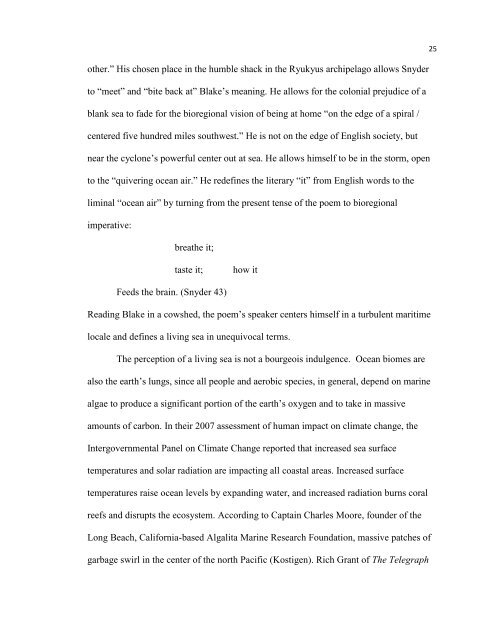RE-INHABITING THE ISLANDS - The University of North Carolina at ...
RE-INHABITING THE ISLANDS - The University of North Carolina at ...
RE-INHABITING THE ISLANDS - The University of North Carolina at ...
You also want an ePaper? Increase the reach of your titles
YUMPU automatically turns print PDFs into web optimized ePapers that Google loves.
other.‖ His chosen place in the humble shack in the Ryukyus archipelago allows Snyder<br />
to ―meet‖ and ―bite back <strong>at</strong>‖ Blake‘s meaning. He allows for the colonial prejudice <strong>of</strong> a<br />
blank sea to fade for the bioregional vision <strong>of</strong> being <strong>at</strong> home ―on the edge <strong>of</strong> a spiral /<br />
centered five hundred miles southwest.‖ He is not on the edge <strong>of</strong> English society, but<br />
near the cyclone‘s powerful center out <strong>at</strong> sea. He allows himself to be in the storm, open<br />
to the ―quivering ocean air.‖ He redefines the literary ―it‖ from English words to the<br />
liminal ―ocean air‖ by turning from the present tense <strong>of</strong> the poem to bioregional<br />
imper<strong>at</strong>ive:<br />
bre<strong>at</strong>he it;<br />
25<br />
taste it;<br />
how it<br />
Feeds the brain. (Snyder 43)<br />
Reading Blake in a cowshed, the poem‘s speaker centers himself in a turbulent maritime<br />
locale and defines a living sea in unequivocal terms.<br />
<strong>The</strong> perception <strong>of</strong> a living sea is not a bourgeois indulgence. Ocean biomes are<br />
also the earth‘s lungs, since all people and aerobic species, in general, depend on marine<br />
algae to produce a significant portion <strong>of</strong> the earth‘s oxygen and to take in massive<br />
amounts <strong>of</strong> carbon. In their 2007 assessment <strong>of</strong> human impact on clim<strong>at</strong>e change, the<br />
Intergovernmental Panel on Clim<strong>at</strong>e Change reported th<strong>at</strong> increased sea surface<br />
temper<strong>at</strong>ures and solar radi<strong>at</strong>ion are impacting all coastal areas. Increased surface<br />
temper<strong>at</strong>ures raise ocean levels by expanding w<strong>at</strong>er, and increased radi<strong>at</strong>ion burns coral<br />
reefs and disrupts the ecosystem. According to Captain Charles Moore, founder <strong>of</strong> the<br />
Long Beach, California-based Algalita Marine Research Found<strong>at</strong>ion, massive p<strong>at</strong>ches <strong>of</strong><br />
garbage swirl in the center <strong>of</strong> the north Pacific (Kostigen). Rich Grant <strong>of</strong> <strong>The</strong> Telegraph
















